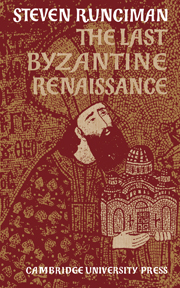3 - THE SCHOLARS
Summary
In these modern days when a sharp line is drawn between the humanities and the sciences it is a relief to look back to an age when a cultured man was expected to take an interest in all branches of human knowledge. The ‘complete man’ of the Italian Renaissance represented an ideal that only a Michelangelo or a Leonardo could reach. But he was foreshadowed by Western medieval scholars such as Roger Bacon, and by the best scholars of Byzantium, especially during the last two centuries of the Christian Empire.
There was a gap in the completeness. The Byzantine scholars made no attempts to be painters or sculptors. Practising artists did not enjoy a high status in Byzantium, great as was the Byzantine devotion to art. Except for a few manuscript miniaturists and a few frescopainters working on the perimeter of the Byzantine world, scarcely one Byzantine artist is known to us by name, and only one architect, the Armenian Tirdat, since the days of Justinian; and the great architects of Justinian's time, Anthemius of Tralles and Isidore of Miletus, and Isidore's nephew and namesake, the architects of Saint Sophia, were more renowned as geometricians than as the designers of buildings. In the ninth century Photius could describe the New Basilica of the Emperor Basil I without any mention of its architect or its decorators. This was largely because the Byzantine never thought in terms of individual works of art. A picture or a carving was to be seen in its setting, as part of a whole; and the whole was the product of a team.
- Type
- Chapter
- Information
- The Last Byzantine Renaissance , pp. 49 - 84Publisher: Cambridge University PressPrint publication year: 1970

